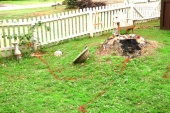posted 11 years ago
We have finally got the house we've been trying to buy for three months now-Woohoo! We are on 1.5 acres, just far enough outside of our little city to be considered rural. Over half of it is well established woodland. It was what really sold me on this place-I'm so excited to have all of that to start off working with!
However, it is very daunting to think about how to get in there and transform it little by little. I mean I've fantasized about this day, but now that there is so much room to work with, and so much to learn, it feels a little overwhelming. Where should I start? I'm assuming at the edge closest to me. What should I lop down? What should I leave? Identifying everything will be an adventure unto itself-haha!
I've identified some willows, mimosa, sweet gum, pines, sumacs, honeysuckle, blackberry, and pecan trees so far. Our neighboring property on the south side is a wide unused pastureland with a giant pond/small lake on it. There is a steep drop off from that pastureland into our wooded area, and a place where the water sometimes forms a small stream on our property. I haven't had a chance to examine it up close as I am still terrified of trompsing around in the thick woodland, but I spotted water from the back of the shed (which is right against the wooded area nestled in between two pecan trees).
Speaking of being terrified, we ran over a yellow jacket nest in the middle of the front/side yard with a lawn mower. Wasp nests abound around the house and throughout the shed. The house has not been lived in for a year and half and there was old rat poison and poop in a lot of the lower cabinets. I love nature, I want it to teach me all of its secrets, but right now this property seems so dangerous with all of these little hidden hazards. I want to be surrounded by nature, but not to be afraid of it.
I wonder does anyone have any suggestions for making the place feel safe without having to do bad things to the environment? I mean, I would like to know that I can walk in my yard without being swarmed by yellow jackets (those buggers are MEAN!). I would like to go out into the mystery shed without wondering if something is going to fall from the rafters or snap out from behind an old tire or box. Part of me feels like the only way to start from scratch on the safety measures is to jump in there with a bug bomb or whatnot. There's gotta be a better way, though. I know in the yard and garden things should probably work themselves out as it is transformed, but how do I get started if I'm too afraid to venture out?
So does anyone have any advice on the conversion of the woodland? Or any suggestions on how I can clean everything out and feel safe with minimal hazard to my person minus poisoning everything living just to start fresh?
And, just a reminder, I live in northeast Alabama. I think that is zone 8a or 8b or somewhere straddling that line maybe. I would love input from any and everyone, but if anyone has experience with a food forest situation in an area near or similar to mine, I would appreciate your input even more.
THANKS!!





 1
1




 i told him they would be too afraid of all the noise he makes to come in the back yard.
i told him they would be too afraid of all the noise he makes to come in the back yard.
 3
3




 2
2




 1
1




 And I too have a daughter who just turned one so I foresee her wanting to explore as well.
And I too have a daughter who just turned one so I foresee her wanting to explore as well. 1
1
















 1
1












